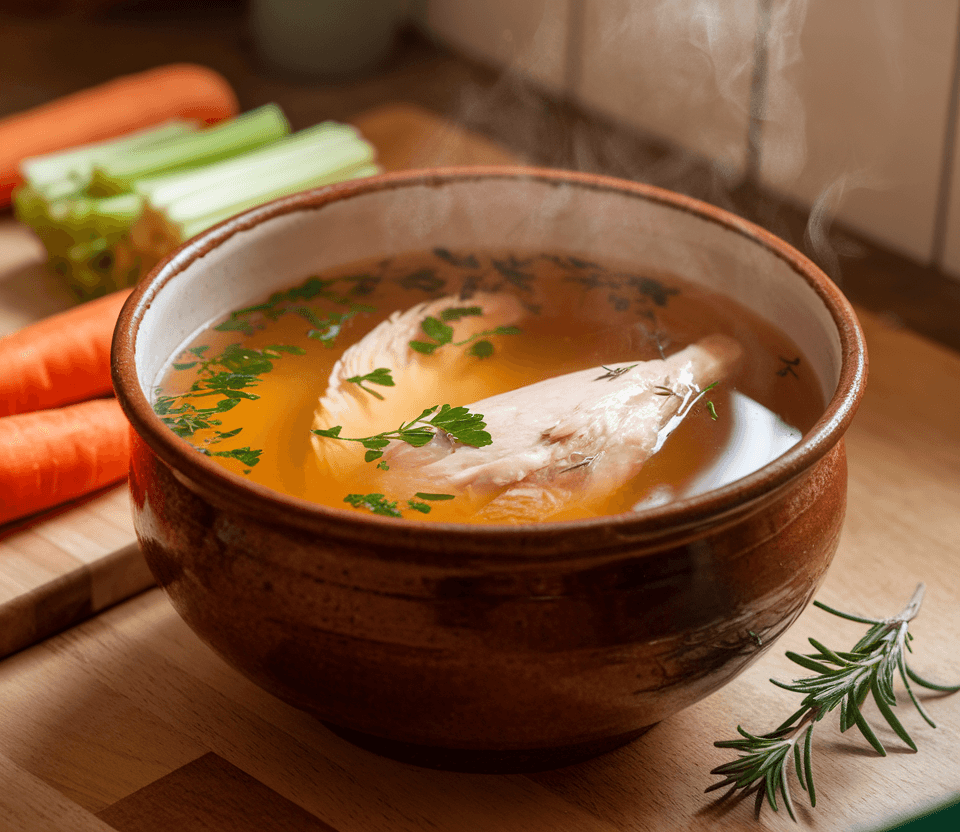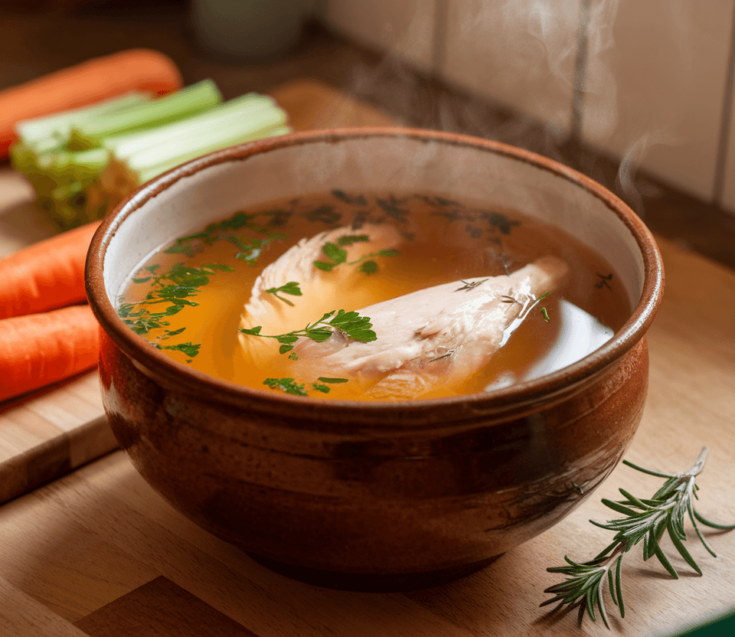Chicken Stock is one of those quintessential kitchen staples that can elevate your cooking to new heights. Rich, flavorful, and incredibly versatile, this homemade chicken stock recipe is perfect for soups, sauces, risottos, and many other dishes. By simmering chicken bones with aromatic vegetables and herbs, you’ll extract a depth of flavor that is simply unmatched by store-bought options. Plus, making your own stock allows you to control the ingredients and tailor the flavors to your liking.

Why You Will Love This Recipe
This chicken stock recipe is beloved for its rich and comforting flavor that brings warmth to any dish. The ease of cooking makes it accessible for everyone, from culinary novices to seasoned chefs. With just a few ingredients and minimal hands-on time, you can create a stock that’s full of nutrients and flavor. It fits perfectly into a healthy lifestyle, allowing you to avoid preservatives and additives often found in pre-packaged stocks. Plus, it’s an excellent way to use leftover chicken bones, making it both economical and sustainable.
Tips and Tricks
- Use a Variety of Ingredients: Incorporate different vegetables like leeks, celery, and carrots to add complexity to the flavor.
- Roast the Bones: For a deeper flavor, roast the chicken bones in the oven before adding them to the stockpot.
- Skim the Foam: As the stock simmers, a foam will rise to the top. Skimming this off can help clarify your stock and improve its flavor.
- Use a Cheesecloth: For easy straining, consider using a cheesecloth to wrap your herbs and spices, making them easier to remove after cooking.
Common Mistakes to Avoid
- Overcooking: Avoid simmering the stock too long, as it can turn bitter. Aim for a simmer of 4-6 hours.
- Ignoring Seasoning: Don’t be afraid to season your stock with salt, but do so sparingly; you can always add more later.
- Not Straining Properly: Be sure to strain your stock well to remove all solid pieces. A fine mesh strainer works best for this.
- Using Low-Quality Ingredients: The quality of your stock is directly related to the quality of your ingredients, so opt for organic or high-quality chicken and vegetables whenever possible.
Make Ahead Tips
You can easily prepare chicken stock ahead of time. Roast the bones and chop your vegetables a day in advance and store them in the refrigerator. The stock itself can be made in bulk and stored for later use. Once cooled, it can be kept in the refrigerator for up to 5 days or frozen for up to 6 months. Just be sure to leave some space in your containers, as liquids expand when frozen.
Recipe Variations
- Herb-Infused Stock: Add fresh herbs like thyme, parsley, or dill for an aromatic touch.
- Spicy Stock: Incorporate a couple of dried chilies or a dash of cayenne pepper for a spicy kick.
- Vegetarian Stock: Substitute chicken with mushrooms and add more vegetables like tomatoes and bell peppers for a hearty vegetarian alternative.
- Slow Cooker Method: Use a slow cooker to simmer your stock overnight for a hands-off approach.

How to Serve
Once your chicken stock is ready, it can be used as a base for many dishes. Serve it as a warm broth in a bowl, garnished with fresh herbs for a rustic touch. It’s also perfect for soups, risottos, or sauces. For an elegant presentation, ladle the stock into a clear bowl or a rustic pot and sprinkle with finely chopped parsley or chives.
Pairing Suggestions
Pair your chicken stock with a light-bodied white wine like Sauvignon Blanc for a refreshing contrast. If you prefer non-alcoholic options, a glass of herbal tea or sparkling water with lemon would complement the flavors beautifully. For side dishes, consider crusty bread or a simple green salad to round out the meal.
How to Store
Store leftover chicken stock in airtight containers in the refrigerator for up to 5 days. For longer storage, pour the stock into freezer-safe bags or containers, leaving some space for expansion. Stock can be frozen for up to 6 months. When reheating, do so gently on the stove over low heat, stirring occasionally until warmed through.
Equipment Needed
- Large stockpot or Dutch oven
- Fine mesh strainer or cheesecloth
- Roasting pan (if roasting bones)
- Cutting board and knife for chopping vegetables
Dietary Adaptations
For a vegan version, replace chicken with a variety of mushrooms and vegetable scraps. Use vegetable broth instead of chicken bones, and enhance flavors with seaweed like kombu. For gluten-free needs, ensure that any added seasonings are gluten-free.
Seasonal Adaptations
In winter, use hearty root vegetables like parsnips and turnips along with the traditional carrots and celery. In spring and summer, fresh herbs and lighter vegetables like zucchini or asparagus can add a fresh twist to your stock.
Cost Breakdown
This chicken stock recipe is incredibly budget-friendly. The total cost of ingredients for a large batch can range from $10 to $15, yielding several cups of rich stock. To cut costs, use leftover chicken bones and vegetable scraps that would otherwise go to waste.
Kitchen Hacks
- Freeze Herb Scraps: Whenever you have leftover herbs, chop and freeze them in ice cube trays with some olive oil. They can be added directly to your stock for extra flavor.
- Quickly Peel Garlic: Smash cloves with the flat side of a knife to make peeling easier and quicker.
- Use a Pressure Cooker: If you’re short on time, use a pressure cooker to make stock faster; it can significantly reduce cooking time while still yielding a rich flavor.
Recipe FAQs
- Can I use store-bought chicken bones? Yes, you can use leftover rotisserie chicken bones or any other cooked chicken bones for this recipe.
- How long should I simmer the stock? A simmer of 4 to 6 hours is ideal for extracting flavor without turning bitter.
- Can I make this stock in advance? Absolutely! It can be made in advance and stored in the fridge or freezer for later use.
Chicken Stock

Chicken Stock is one of those quintessential kitchen staples that can elevate your cooking to new heights. Rich, flavorful, and incredibly versatile, this homemade chicken stock recipe is perfect for soups, sauces, risottos, and many other dishes.
Ingredients
- 2-3 pounds of chicken bones (such as carcasses or wings)
- 2 large carrots, chopped
- 2 celery stalks, chopped
- 1 onion, quartered
- 4 cloves of garlic, smashed
- 1-2 bay leaves
- Fresh herbs (such as thyme, parsley, or rosemary)
- Salt and pepper to taste
- 12 cups of water
Instructions
- Prepare Ingredients: If desired, roast the chicken bones in a preheated oven at 400°F (200°C) for 30-40 minutes until golden brown.
- Combine Ingredients: In a large stockpot or Dutch oven, add the roasted chicken bones, carrots, celery, onion, garlic, herbs, and bay leaves.
- Add Water: Pour in 12 cups of water, ensuring the bones and vegetables are fully submerged.
- Bring to a Simmer: Place the pot over medium-high heat and bring to a boil. Once boiling, reduce the heat to low to maintain a gentle simmer.
- Skim Foam: As the stock simmers, skim off any foam that forms on the surface.
- Simmer: Let the stock simmer for 4-6 hours, adding more water if needed to keep ingredients submerged.
- Strain the Stock: Once done, remove the pot from heat. Strain the stock through a fine mesh strainer or cheesecloth into a large bowl or another pot, discarding the solids.
- Cool and Store: Let the stock cool completely before transferring it to storage containers.
Nutrition Information
Yield
10Serving Size
1Amount Per Serving Calories 312Total Fat 18gSaturated Fat 5gTrans Fat 0gUnsaturated Fat 11gCholesterol 128mgSodium 152mgCarbohydrates 3gFiber 1gSugar 1gProtein 33g
Dinnerfocus.com, occasionally offers nutritional information for recipes contained on this site. This information is provided as a courtesy and is an estimate only. This information comes from online calculators. Although allchickenrecipes.com attempts to provide accurate nutritional information, these figures are only estimates.
Final Thoughts
Making your own chicken stock may seem like a simple task, but the depth of flavor it brings to your meals is profound. This recipe not only provides a delicious base for countless dishes but also fosters a sense of accomplishment in the kitchen. Once you master this chicken stock recipe, you’ll find it hard to return to store-bought alternatives. Happy cooking!
